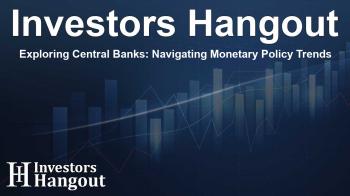Exploring Central Banks: Navigating Monetary Policy Trends

Understanding Central Banks and Their Policies
Central banks often implement interest rate cuts gradually, typically in 25 basis point increments. This practice raises questions about its effectiveness in today's economic landscape. As we analyze the monetary policy, one curiosity arises: Should the European Central Bank (ECB) consider cutting rates in the midst of an ever-changing economy?
Insights on Interest Rate Adjustments
Traditionally, there are unwritten rules defining how central banks operate. For example, in the UK, subtle social norms dictate many behaviors. Similarly, financial practices have evolved organically, creating expectations around interest rate changes.
However, the current economic environment calls for a different approach. Today, fixed-rate mortgages are common, and companies heavily rely on hedging strategies. This shift implies that isolated, smaller rate cuts may not yield significant results.
During the aggressive interest rate hike cycle of recent years, we saw the average interest on outstanding U.S. mortgage debt increase marginally, even as rates for new loans skyrocketed. This scenario underscores the complexities central banks face today in steering monetary policy.
Consider the Bank of England (BoE). There exists a divide among its policymakers, particularly between hawks and doves. While some advocate for immediate cuts, others remain skeptical about the timing, especially in light of fluctuating inflation data. This impending tension showcases the delicate balance the BoE must strike.
Moreover, a cautious approach is crucial, as signs indicate the potential for economic strain. Should economic pressures continue to rise, we may see an acceleration in rate adjustments moving forward.
The Federal Reserve's Challenges
The Federal Reserve faces a complicated environment influenced by fluctuating inflation rates. As it evaluates potential economic risks, particularly from tariff impacts, careful deliberation is necessary. Recent benign inflation readings offer some relief, yet the risk of unexpected increases persists.
Notably, some economists predict that when the Fed decides to cut rates, it may opt for a more significant, bold move rather than gradualism, reflecting a shift in strategy. This expectation echoes the previous response patterns observed in prior economic circumstances.
Potential ECB Rate Movements
The ECB appears to be inching toward the conclusion of its easing cycle. The current rates are neutral, reflecting neither stimulatory nor restrictive stance for growth. As such, while debates about potential cuts arise, most anticipate a wait-and-see approach given the global economic climate.
Market sentiments indicate that confidence in Europe may be waning, evident in declining business outlooks. Upcoming PMI figures will likely reveal much about the health of both the consumer sector and overall economic activity.
Future Expectations in Eastern Europe
As we turn our focus to Eastern European countries, the financial landscapes remain diverse. For instance, in Poland, manufacturing growth remains stagnant, reflecting broader EU economic struggles. This trend carries implications for employment rates, which have held steady but show signs of potential weakness moving forward.
Moreover, Hungary's persistent inflation expectations pose challenges for monetary policy strategy, making any plans for easing unlikely unless significant economic shifts occur.
Key Economic Developments to Watch
- The U.S. faces a quiet week regarding scheduled data due to the Fed’s ongoing deliberation period ahead of critical meetings.
- In the Eurozone, the ECB's cautious tracking of economic indicators is critical as consumers and businesses appear to be increasingly uncertain.
- Across Central and Eastern Europe, labor market indicators, retail spending trends, and trade dynamics will play pivotal roles in shaping monetary policies.
- Upcoming discussions surrounding fiscal stimulus in Germany could impact the Eurozone's economic recovery trajectory significantly.
- As various countries prepare for their monetary decisions, insights from experts will remain crucial in understanding outcomes.
Frequently Asked Questions
What are the recent trends in interest rate cuts?
Interest rate cuts have been gradual, traditionally in 25 basis point increments, though economic conditions are prompting discussions for more immediate action.
How does the current economic climate affect central bank policies?
The current financial landscape, characterized by fixed-rate mortgages and corporate hedging, demands more nuanced approaches to rate adjustments.
What challenges does the Federal Reserve face?
The Fed contends with fluctuating inflation and potential tariff risks that complicate timely monetary policy decisions.
What is the ECB's current stance on rates?
The ECB is maintaining a wait-and-see approach, as current rates are neutral and global economic conditions demand caution.
Why is there a divide among policymakers in the UK?
BoE officials are split, with some advocating for immediate cuts and others cautious, reflecting broader uncertainties in the economic outlook.
About The Author
Contact Logan Wright privately here. Or send an email with ATTN: Logan Wright as the subject to contact@investorshangout.com.
About Investors Hangout
Investors Hangout is a leading online stock forum for financial discussion and learning, offering a wide range of free tools and resources. It draws in traders of all levels, who exchange market knowledge, investigate trading tactics, and keep an eye on industry developments in real time. Featuring financial articles, stock message boards, quotes, charts, company profiles, and live news updates. Through cooperative learning and a wealth of informational resources, it helps users from novices creating their first portfolios to experts honing their techniques. Join Investors Hangout today: https://investorshangout.com/
The content of this article is based on factual, publicly available information and does not represent legal, financial, or investment advice. Investors Hangout does not offer financial advice, and the author is not a licensed financial advisor. Consult a qualified advisor before making any financial or investment decisions based on this article. This article should not be considered advice to purchase, sell, or hold any securities or other investments. If any of the material provided here is inaccurate, please contact us for corrections.

